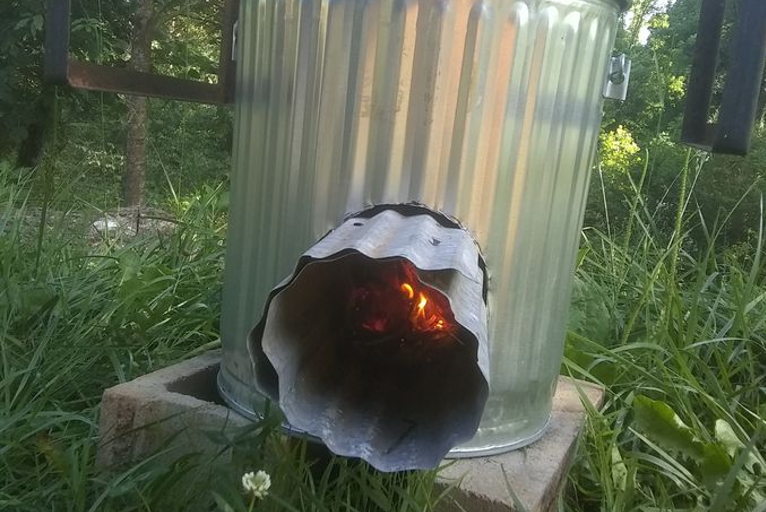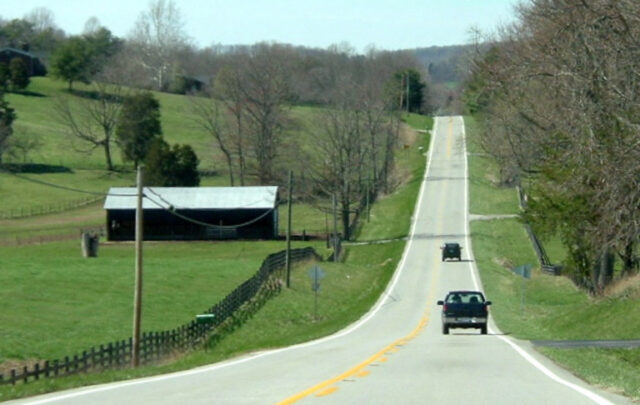I’ve gotten a lot of use out of my cinder block rocket stove. It made dinner, but it also heated the scalding water for all the poultry I processed through last fall and winter, which ended up being more than I intended. That’s a lot of mileage for a device built out of stuff that was lying around.
However, it had a few drawbacks. Water that sloshed over the side of my giant scalding pot tended to drown the fire just slightly. Not a big problem if for cooking, but less than ideal for scalding.
It was also awkward to move around, heavy as it was and in so many pieces. And after over a dozen uses, a block or two cracked (these were salvage from the tear-down houses on our land, so they were who knows how many years old). It was a great throw-together solution and that would do just fine in an emergency, but not quite convenient enough to inspire really frequent use.
Then, we offered to help some friends process birds at their place. Who doesn’t want to pluck and gut in July in the South? Well, everyone, of course. But their processor fell through and even though they found a new one for most of the flock, they were still interested in skilling up. We are always interested in supporting that. But I was not hauling a trunk-load of antique soot-blackened cinder blocks half way across the state!

I’m going to work up a better-fitting grill for the top, but at the moment i’m just using the grill from my fire bowl.
Enter this little beauty. The spirit of salvage is honored here, because while I bought the exterior can at Tractor Supply, everything else was, you guessed it, lying around. This is not a 33-gallon feed can, but a smaller iteration apparently intended for holding wild bird seed. I was not aware so many people are that serious about feeding their birds. (And if you are it might be a good idea to pause right now, because we now have that mystery bird illness here in NC).
The feed pipe and riser are corrugated metal roofing off one of the tear-down projects on our land. The feed pipe has a diameter of 7” and a length of 12”. The riser is more like 9” in diameter in order to accommodate the feed pipe, and 17” in height, and it’s made out of two overlapping sections of 24”-wide roofing. I cut the hole in the can and the hole in the riser using tin snips, and used a few regular screws to hold it together. The height is just right to fit in the trunk of our little Toyota Yaris.

From this angle you can see the smoke notches in the riser, that draw the heat striaght to the pan.
There’s a corrugated secondary bottom with a couple of spare firebricks underneath. Several half-bricks are wedged between the riser and the sides of the can, with airspace above. The bricks weight the can to make it more stable, which is a critical feature if you’re going to have four gallons of almost-boiling water sitting on top of the whole thing. The purpose of the air space is to keep the outside of the can from getting nuclear, but it still gets hot. A little rock wool instead of air might not go amiss.
Total cost: $20.
I gave it a trial run to make sure I had the dimensions right-enough. It cooked our dinner on a little bit of kindling and two 2”x2”x10”s sawed off a larger board during a recent project (salvage wood, not kiln-dried). That was definitely overkill; the rice was done in about nine minutes, before the curry was even ready to go on.
On processing day I discovered it performed better than the cinder block stove in several respects. First, it heated the water so much faster that I had to add a bunch of cold because the birds weren’t ready yet. Plus I only fed it three times, as compared to around five with the cinder block version. Two feeds definitely would have sufficed, if I wasn’t perpetually concerned about the water getting too cold for the last bird. It scalded 8 birds on some kindling and five of those 2”x2”x10”s, and we probably could have done three more before it got cold.
What’s more, the curved lid of the bird seed can performed exactly as I’d hoped, directing slopped water off the contraption and saving the fire. It does smoke when it’s first lit, but not much after that, and I can hear the rocket stove whoosh. All in all I think it’s more comfortable to cook on than my fire bowl or a grill in the 95-degree summer weather, but slightly hotter and smokier than my dual-fuel Coleman. It also seems to be about as fast as the Coleman (as long as I’ve got the wood to hand and don’t have to forage far), which is critical for dinners during the busy season.
I was so happy with that performance that the following day I attempted the most ambitious rocket stove test yet. We’d picked a couple of gallons of wild blackberries that morning, and I used the stove to boil the berries down and can them into jam. It worked like a charm.

You can just see the flame peaking out from under the pot.
Hesitant to scorch the jam, I under-fired the stove at first, which was a mistake. It lengthened the process, but otherwise no harm done. Next time I’ll just light like regular, with a couple larger pieces placed vertically in the riser and kindling poked in from the side. I lost track of how many pieces of wood I used, but it was about half a half-bushel box. Since the stove was already lit I went ahead and made beet fried rice for dinner. Love that good hot natural flame for fried rice. Then I used the hot canning water to wash all the dishes.
All in all, that tiny bit of wood did a lot of work, which is important because in general using wood is less efficient than other options.

Next time I can, I’ll drop a slightly bigger stick down the riser when I switch pots, which will bring the canner up to temperature a little faster. The stove is really responsive to diameter and quantity of wood, and I’m still fine-tuning my instincts.
As I’ve continued to test this stove, I’ve come to the conclusion that I think I’d still like to have something smaller in addition. It’s easy to over-fire it for just a single pan of food or pot of water. Like any skill, it will take me a little while to get it right every time. Also, these probably aren’t forever materials, unlike something like solo stoves which are made out of stainless steel. But it’ll definitely last longer than salvage cinder blocks.
Hurricane season has arrived, and it’s a load off my mind to know that I could cook dinner efficiently and conveniently regardless of the power and gas situation. What’s your stove back-up plan?






